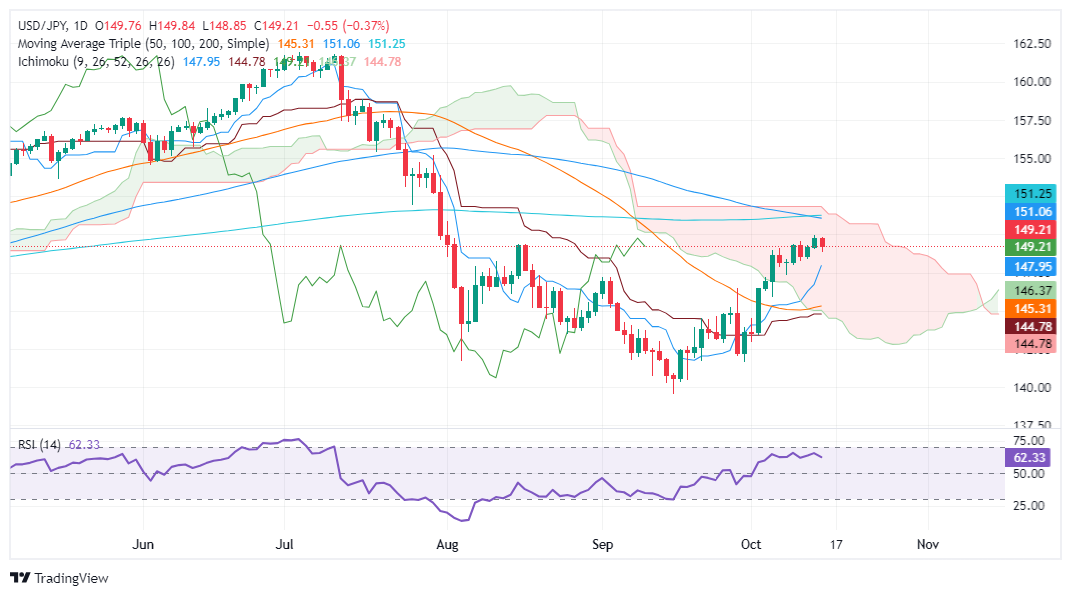- USD/JPY falls to 149.21 as the US 10-year Treasury yield falls more than eight basis points.
- Despite the recent decline, the pair remains in a neutral to bullish stance, oscillating within the Ichimoku Cloud.
- Key support at 149.00; a break below could trigger further declines towards 147.95 and beyond.
USD/JPY fell more than 0.30% on Tuesday due to risk aversion and falling US Treasury yields. The US 10-year benchmark rate plummeted more than eight basis points (bp) and pushed the exchange rate down due to its positive correlation with the pair. At the time of writing, the main pair is trading at 149.21, flat entering the Asian session on Wednesday.
USD/JPY Price Forecast: Technical Outlook
The daily chart suggests that USD/JPY is steadily pointing higher, although it has a neutral to bullish bias.
Although technical signals suggest that buyers are in control, USD/JPY remains within the Ichimoku (Kumo) Cloud and limits its advance. Furthermore, despite being bullish, the Relative Strength Index (RSI) has failed to surpass the last three peaks, showing that the uptrend could be overextended.
With USD/JPY rising above 150.00, this clears the way for an upward move towards the 100-day moving average (DMA) at 150.98, before the 200-day DMA at 151.27.
If USD/JPY falls below 149.00, the Tenkan-Sen at 147.95 emerges as the first line of defense for the bulls. Once broken, the Senkou Span A at 146.48, followed by the 50-day DMA at 145.36, would be the next key support levels.
USD/JPY Price Action – Daily Chart
The Japanese Yen FAQs
The Japanese Yen (JPY) is one of the most traded currencies in the world. Its value is determined broadly by the performance of the Japanese economy, but more specifically by the policy of the Bank of Japan, the differential between the yields of Japanese and US bonds or the risk sentiment among traders, among other factors.
One of the mandates of the Bank of Japan is currency control, so its movements are key for the Yen. The BoJ has intervened directly in currency markets on occasion, usually to lower the value of the Yen, although it often refrains from doing so due to the political concerns of its major trading partners. The BoJ’s current ultra-loose monetary policy, based on massive stimulus to the economy, has caused the depreciation of the Yen against its main currency pairs. This process has been exacerbated more recently by a growing policy divergence between the Bank of Japan and other major central banks, which have opted to sharply raise interest rates to combat decades-old levels of inflation.
The Bank of Japan’s ultra-loose monetary policy stance has led to increased policy divergence with other central banks, particularly the US Federal Reserve. This favors the widening of the spread between US and Japanese 10-year bonds, which favors the Dollar against the Yen.
The Japanese Yen is often considered a safe haven investment. This means that in times of market stress, investors are more likely to put their money in the Japanese currency due to its supposed reliability and stability. In turbulent times, the Yen is likely to appreciate against other currencies that are considered riskier to invest in.
Source: Fx Street
I am Joshua Winder, a senior-level journalist and editor at World Stock Market. I specialize in covering news related to the stock market and economic trends. With more than 8 years of experience in this field, I have become an expert in financial reporting.








